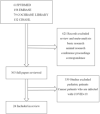Advances in the use of ECMO in oncology patient
- PMID: 37458111
- PMCID: PMC10469637
- DOI: 10.1002/cam4.6288
Advances in the use of ECMO in oncology patient
Abstract
Background: Over the past decade, ECMO has provided temporary cardiopulmonary support to an increasing number of patients, but the use of extracorporeal membrane oxygenation (ECMO) to provide temporary respiratory and circulatory support to adult patients with malignancy remains controversial.
Objectives: This paper reviews the specific use of extracorporeal membrane oxygenation (ECMO) in oncology patients.
Methods: We searched PubMed, CINAHL, Cochrane Library, and Embase databases for studies on the use of ECMO in cancer patients between 1998 and 2022. Twenty-four retrospective, prospective, and case reports were included. The primary outcome was survival during extracorporeal membrane oxygenation.
Results: Most studies suggest that ECMO can be used in oncology patients requiring life support during surgery, solid tumor patients with respiratory failure, and hematological tumor patients requiring ECOM as a supportive means of chemotherapy; however, in patients with hematologic oncology undergoing hematopoietic stem cell transplantation, there was no clear benefit after the use of ECMO.
Conclusion: Current research suggests that ECMO may be considered as a salvage support in specific cancer patients. Future studies should include larger sample sizes than those already conducted, including studies on efficacy, adverse events, and health.
Keywords: cancer patient; extracorporeal membrane oxygenation; intensive care unit.
© 2023 The Authors. Cancer Medicine published by John Wiley & Sons Ltd.
Conflict of interest statement
The authors declare that they have no competing interests.
References
-
- Bray F, Ferlay J, Soerjomataram I, Siegel RL, Torre LA, Jemal A. Global cancer statistics 2018: GLOBOCAN estimates of incidence and mortality worldwide for 36 cancers in 185 countries. CA Cancer J Clin. 2018;68(6):394‐424. - PubMed
-
- Azoulay E, Mokart D, Pène F, et al. Outcomes of critically ill patients with hematologic malignancies: prospective multicenter data from France and Belgium—a groupe de recherche respiratoire en réanimation onco‐hématologique study. J Clin Oncol. 2013;31(22):2810‐2818. - PubMed
-
- Azoulay E, Afessa B. The intensive care support of patients with malignancy: do everything that can be done. Intensive Care Med. 2006;32(1):3‐5. - PubMed
-
- Noah MA, Peek GJ, Finney SJ, et al. Referral to an extracorporeal membrane oxygenation center and mortality among patients with severe 2009 influenza A (H1N1). Jama. 2011;306(15):1659‐1668. - PubMed
Publication types
MeSH terms
LinkOut - more resources
Full Text Sources
Medical
Miscellaneous


